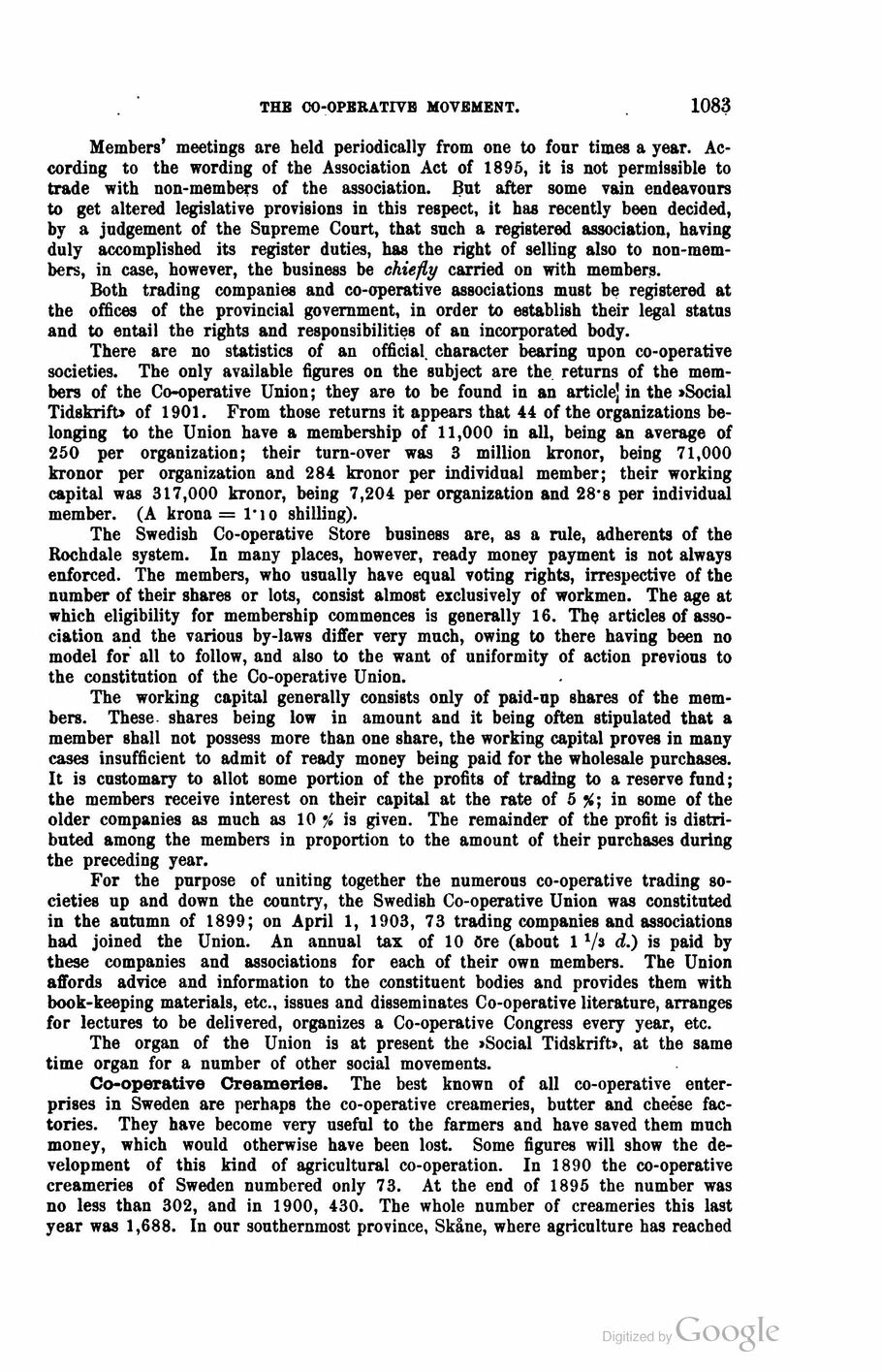
Full resolution (JPEG) - On this page / på denna sida - Second part - XVI. Labour Legislation and Social Statistics - 2. Social Condition and Social Statistics - The Co-operative Movement, by G. H. von Koch, Editor, Stockholm

<< prev. page << föreg. sida << >> nästa sida >> next page >>
Below is the raw OCR text
from the above scanned image.
Do you see an error? Proofread the page now!
Här nedan syns maskintolkade texten från faksimilbilden ovan.
Ser du något fel? Korrekturläs sidan nu!
This page has never been proofread. / Denna sida har aldrig korrekturlästs.
tub co-opbrativb movement.
1083
Members’ meetings are held periodically from one to four times a year.
According to the wording of the Association Act of 1895, it is not permissible to
trade with non-members of the association. But after some vain endeavours
to get altered legislative provisions in this respect, it has recently been decided,
by a judgement of the Supreme Court, that such a registered association, having
duly accomplished its register duties, has the right of selling also to
non-mem-bers, in case, however, the business be chiefly carried on with members.
Both trading companies and co-operative associations must be registered at
the offices of the provincial government, in order to establish their legal status
and to entail the rights and responsibilities of an incorporated body.
There are no statistics of an official, character bearing upon co-operative
societies. The only available figures on the subject are the returns of the
members of the Co-operative Union; they are to be found in an articlej in the »Social
Tidskrift» of 1901. From those returns it appears that 44 of the organizations
belonging to the Union have a membership of 11,000 in all, being an average of
250 per organization; their turn-over was 3 million kronor, being 71,000
kronor per organization and 284 kronor per individual member; their working
capital was 317,000 kronor, being 7,204 per organization and 28-s per individual
member. (A krona = l’io shilling).
The Swedish Co-operative Store business are, as a rule, adherents of the
Rochdale system. In many places, however, ready money payment is not always
enforced. The members, who usually have equal voting rights, irrespective of the
number of their shares or lots, consist almost exclusively of workmen. The age at
which eligibility for membership commences is generally 16. The articles of
association and the various by-laws differ very much, owing to there having been no
model for all to follow, and also to the want of uniformity of action previous to
the constitution of the Co-operative Union.
The working capital generally consists only of paid-up shares of the
members. These, shares being low in amount and it being often stipulated that a
member shall not possess more than one share, the working capital proves in many
cases insufficient to admit of ready money being paid for the wholesale purchases.
It is customary to allot some portion of the profits of trading to a reserve fund;
the members receive interest on their capital at the rate of 5 %; in some of the
older companies as much as 10 % is given. The remainder of the profit is
distributed among the members in proportion to the amount of their purchases during
the preceding year.
For the purpose of uniting together the numerous co-operative trading
societies up and down the country, the Swedish Co-operative Union was constituted
in the autumn of 1899; on April 1, 1903, 73 trading companies and associations
had joined the Union. An annual tax of 10 Ore (about 11/s d.) is paid by
these companies and associations for each of their own members. The Union
affords advice and information to the constituent bodies and provides them with
book-keeping materials, etc., issues and disseminates Co-operative literature, arranges
for lectures to be delivered, organizes a Co-operative Congress every year, etc.
The organ of the Union is at present the »Social Tidskrift», at the same
time organ for a number of other social movements.
Co-operative Creameries. The best known of all co-operative
enterprises in Sweden are perhaps the co-operative creameries, butter and cheese
factories. They have become very useful to the farmers and have saved them much
money, which would otherwise have been lost. Some figures will show the
development of this kind of agricultural co-operation. In 1890 the co-operative
creameries of Sweden numbered only 73. At the end of 1895 the number was
no less than 302, and in 1900, 430. The whole number of creameries this last
year was 1,688. In our southernmost province, Skåne, where agriculture has reached
<< prev. page << föreg. sida << >> nästa sida >> next page >>